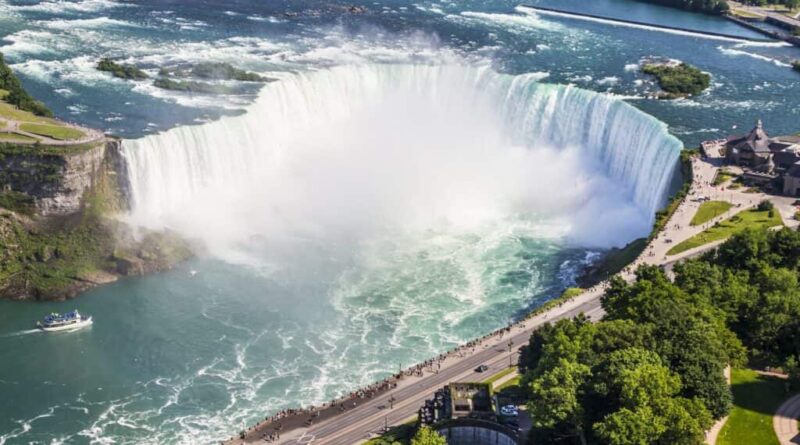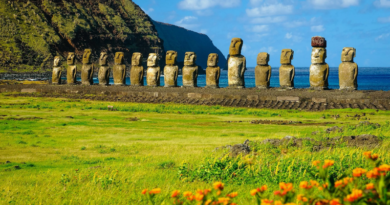7 Breathtaking Natural Wonders You Must Witness see to Believe
1: The Grand Canyon, United States

Stretching an impressive 277 miles in length and descending to depths of over a mile, the Grand Canyon stands as an awe-inspiring testament to the relentless power of erosion. Nestled in the heart of Arizona, USA, this colossal geological marvel unveils a captivating narrative etched in the layers of rock that span millions of years. As you stand on its rim, the sheer scale and intricate formations of the Grand Canyon leave you breathless, offering a humbling reminder of the Earth’s remarkable history.
This remarkable chasm is not merely a physical wonder but a time capsule of our planet’s evolution, showcasing the slow and patient work of natural forces. Each layer of rock in the Grand Canyon tells a story of ancient landscapes, changing climates, and the eons-long journey of our planet’s geology. In the presence of this natural wonder, one can’t help but marvel at the grandeur of our world and reflect on the immense power of nature that has shaped it over countless millennia.
2: The Great Barrier Reef, Australia

The Great Barrier Reef, located along Australia’s northeastern coast, stretches an impressive 2,300 kilometers. This extraordinary natural wonder is an underwater paradise teeming with a remarkable variety of marine life. Whether snorkeling or scuba diving, you’ll be captivated by the kaleidoscope of colors as coral formations provide a mesmerizing backdrop to the graceful dance of fish, turtles, and rays. The reef stands as a testament to our planet’s delicate marine ecosystems’ balance and exquisite beauty, emphasizing the importance of preserving these precious underwater habitats for generations to cherish.
Beyond its aesthetic allure, the Great Barrier Reef plays a crucial role in global biodiversity and ecological well-being. It nurtures a diverse ecosystem, providing a sanctuary for countless marine species. Additionally, it acts as a natural buffer, shielding coastal regions from the destructive force of ocean waves and storms. Despite its magnificence, this ecosystem faces multiple threats, including climate change, ocean acidification, and pollution. Prioritizing conservation efforts and embracing sustainable practices are essential to ensuring the perpetual existence of this natural marvel for generations to come
3: The Amazon Rainforest, South America

The Amazon Rainforest, sprawling across nine South American countries, stands as the planet’s most extensive tropical rainforest. It harbors an astonishing diversity of flora and fauna, making it a critical component of Earth’s biodiversity. Delving into the Amazon offers a captivating journey through the jungle’s sights and sounds, granting glimpses of exceptional wildlife and vibrant foliage at every twist and turn. It serves as a poignant reminder of the profound intricacy and interdependence within our natural realm.
Immersing oneself in the Amazon Rainforest, stretching across nine South American countries, unveils the grandeur of the world’s largest tropical rainforest. This verdant haven houses an astounding range of plant and animal species, playing a pivotal role in the planet’s biodiversity. Roaming through the Amazon, one experiences the enchanting symphony of the jungle, encountering unique wildlife and lush vegetation at every corner. It serves as a vivid illustration of the immense complexity and interconnectedness that characterizes our precious natural world .
4: Mount Everest, Nepal

Mount Everest, Earth’s loftiest summit, soars majestically to an astonishing elevation of 8,848 meters amid the Himalayan range. The relentless ascent to its pinnacle is a perilous odyssey, primarily undertaken by seasoned mountaineers. Everest’s sheer magnitude and regal grandeur have an awe-inspiring effect, igniting a profound reverence for nature. When stationed at its base camp, encircled by colossal peaks and sprawling glaciers, one is enveloped in the unbridled might and breathtaking splendor of the natural world.
At a formidable 8,848 meters above sea level, Mount Everest reigns as the planet’s highest peak, proudly nestled within the Himalayas. Scaling its summit is an endeavor fraught with peril, typically reserved for the most adept climbers. The sheer enormity and majestic presence of Everest are enough to elicit profound admiration. Gazing upon it from base camp, enveloped by towering peaks and sprawling glaciers, offers an immersive encounter with the raw power and captivating beauty of the natural world.
5: Victoria Falls, Zambia and Zimbabwe

Victoria Falls, situated at the border between Zambia and Zimbabwe along the Zambezi River, stands as a mesmerizing natural marvel. Spanning a breathtaking 1.7 kilometers in width and plunging a staggering 108 meters in height, this cascade of water emanates a deafening roar and a majestic mist that extends for miles. The sheer force and captivating allure of the cascading water cast a spell on all who behold it, rendering Victoria Falls an indelible testament to the wonders of the natural world.
Its location on the Zambezi River, where Zambia and Zimbabwe converge, underscores the falls’ unparalleled beauty and power. Enveloped by the thunderous resonance and the ethereal mist that blankets the surroundings, visitors are left awestruck by this extraordinary spectacle, forever etching the memory of Victoria Falls into their hearts as an enduring testament to nature’s magnificence.
6: The Great Blue Hole, Belize

The Great Blue Hole, nestled off Belize’s coastline, entices divers with its extraordinary allure. This vast underwater sinkhole, boasting a circular form spanning over 300 meters wide, offers an enthralling gateway to the depths. Descending into its pristine waters reveals a spellbinding world adorned with stalactites, sharks, and a mesmerizing array of marine life. The deep blue chasm and the feeling of buoyancy create an otherworldly encounter, serving as a poignant reminder of the mysteries concealed beneath our planet’s surface.
The Great Blue Hole is a giant marine sinkhole off the coast of Belize. It lies near the center of Lighthouse Reef, a small atoll 70 km (43 mi) from the mainland and Belize City. The hole is circular in shape, 318 m (1,043 ft) across and 124 m (407 ft) deep. It was formed during several phases of the Quaternary glaciation when sea levels were much lower. Analysis of stalactites found in the Great Blue Hole shows that formation took place 153,000, 66,000, 60,000, and 15,000 years ago. As the ocean began to rise again, the cave was flooded. The Great Blue Hole is a part of the larger Belize Barrier Reef Reserve System, a UNESCO World Heritage Site.
Jacques Cousteau, the renowned explorer, declared the Great Blue Hole one of the top five scuba diving sites in the world. In 1971, he brought his ship, the Calypso, to the hole to chart its depths. Investigations confirmed the hole’s origin as typical karst limestone formations, formed before rises in sea level in at least four stages, leaving ledges at depths of 21 m (69 ft), 49 m (161 ft), and 91 m (299 ft). Stalactites retrieved from submerged caves confirmed their previous formation above sea level. The initial measured depth of the Great Blue Hole was about 125 m (410 ft), which remains the most often cited depth. Subsequent expeditions have continued to explore and document this remarkable natural wonder.
In December 2018, two submarines descended into the Blue Hole in an attempt to map its interior. Using sonar scanning, the team nearly completed a 3D map of the 1,000-foot-wide hole. They discovered a layer of hydrogen sulfide at a depth of approximately 300 feet (91 m), where the water becomes dark, anoxic, and devoid of life. The submarine expedition also found the bodies of two divers at the bottom, out of three believed to have gone missing while diving there, and reported them to Belizean authorities.
7: The Aurora Borealis, Northern Hemisphere

The Aurora Borealis, also known as the Northern Lights, is a mesmerizing celestial spectacle that illuminates the polar night skies. These awe-inspiring displays are the result of solar particles colliding with the Earth’s atmosphere, creating a stunning palette of vivid green, pink, and purple hues that adorn the darkness. Observing the graceful, undulating ribbons of light as they dance across the horizon is a profoundly humbling encounter, reminding us of the vastness and splendor of the cosmos.
Gazing upon the Aurora Borealis is like witnessing a cosmic ballet, where nature’s forces blend with the ethereal beauty of the universe. It’s a breathtaking reminder of our planet’s connection to the cosmos and a humbling experience that leaves an indelible mark on those fortunate enough to behold it.




